



|
In Australia, water has – and always will – shape our cities. Dubbed the island continent, Australia has a total coastline length of 35,876km. Yet despite being surrounded by water, it is the driest inhabited continent. As a result, our waterways, harbours, rivers and coastlines are the lifeblood of our cities and have shaped settlement patterns in our country for millennia, from indigenous encampments through to the recent mega ports in many capitals.
Australia has one of the most urbanised, coastal dwelling populations in the world with 8 in 10 Australians living within 50km of the coastline itself and 14 of the 20 largest cities in the nation enjoying a coastal location. In addition, the majority of our inland cities have grown around key water bodies or watercourses. In essence, water is core to the nation’s identity and fundamental to its spirit.
Australia is not alone. Around the world, urban coastal populations are growing at an accelerated rate. Our waterways are becoming many things to many people. They are a means of transportation, a source of economic and commercial return, a tourism opportunity and our single biggest amenity asset providing a stunning setting for parks, recreation and development. Ensuring best practice design of key urban waterfronts is paramount to the success and livability of our cities.
URBAN WATERFRONTS AROUND THE WORLD ARE BEING RE IMAGINED AS HIGHLY PUBLIC, POROUS PLACES THAT DEFINE, INSPIRE AND ENGAGE. THEY OFFER A WHOLE NEW TYPE OF AMENITY LEAD DESTINATION.
Established as a colony during the industrial revolution, Australia’s cities have emerged from an economy dependant on maritime activity. However, while shipping and logistics remain an essential component of our cities economies, they no longer dominate the banks of our inner-city waterfronts. Containerisation has modernised and expanded the industry, providing the necessary impetus for our water’s edge trading environments to migrate downstream and in turn, release valuable waterfront land. At the same time, the on going urbanisation of our cities is demanding more compact forms of development.
As a result, our cities are once again reconnecting with their waterfronts transforming neglected post-industrial docklands into contemporary cultural, recreational and lifestyles spaces blessed with abundant amenity and open spaces. Today, our waterfronts are becoming our cities’ hottest property demanding a 20% uplift in property prices and becoming home to major public facilities and open spaces. Our cities are realising the potential of our waterfront land.
Australia’s waterfront renewal sites are some of the most significant redevelopment projects in the country. Nearly every one of our capital cities is currently home to one of these significant projects. Located in the innercity, these projects are transforming not only the waterfront but the cities themselves. From Melbourne Docklands’ 190ha transformation to the 22ha Barangaroo development on the doorstep of Sydney’s CBD, 260ha Port Adelaide, the combined Riverside, Elizabeth Quay and Perth Stadium projects in Perth and the 304ha Northshore Hamilton PDA in Brisbane.
With over 50 years’ of operation and a decade of national design practice, Urbis has been involved in shaping transformative waterfront developments and public spaces in Australia, Asia and the South Pacific. During this time we have observed a number of key trends that are common to the most successful and popular waterfront places. As some of the most sought after land, it is essential that the redevelopment of these spaces goes beyond merely delivering development.
The following 10 insights represent our collective observations and learnings, in relation to the most successful components of high performance waterfront spaces. These components ensure optimisation of their location and deliver the next evolution of waterfront redevelopment in our cities.
|
As the world’s population continues to grow and urbanise, our cities need to accommodate more people in less space. Transit infrastructure has rightly been a focus for this intensification, however it is amenity that is the essential component as a foci for dense development.
Waterfront sites are blessed with abundant amenity. Characterised by an open edge on one side, every single waterfront site inherently incorporates long views and access to sunlight and breezes. Additionally, all waterfront sites are intrinsically part of a bigger system.
The cumulative benefit of the redevelopment of a network of waterfront sites offers the most significant strategic opportunity for cities. They have the ability to accommodate urban growth, connect city-wide movement networks and become a focus for public urban life. In this way they are more things to more people. As strategic assets they contribute to the sustainable growth of cities and deliver significant public benefit in the process.
KEY FINDINGS
Urbis, in partnership with Brisbane City Council, led the preparation of an inner-city river activation strategy for the Brisbane River. Stretching 22 kilometres from Hamilton to St Lucia. The strategy aimed to provided a co-ordinated decision making framework to promote the river as a world-class recreational, tourism and economic asset for the city.
It identified 12 key outcomes for the inner-city reaches of the river under four key themes: Place, Play, Connect and Enable.
These outcomes promote the places and spaces along the riverfront as destinations for leisure and entertainment, elevate the river’s role as a connector of people and places and reinforces its role as a cultural destination in its own right.
Spanning a 1.5 kilometre long waterfront, the Benidorm Promenade hugs the seafront of this Spanish town unifying the city and the sea through a continuous waterfront pathway with both a singular design and striking colour scheme. A radical innovation in waterfront public space design, the form of the design mimics the shape of waves and cliffs while resolving the change in levels, providing shade and viewing platforms and facilitating regular connections between the town and the beach.

|
City-making today is all about creating authentic experiences.
People everywhere are seeking opportunities to have more meaningful encounters with places and cultures. As tourists, we want to go where the locals go and do what the locals do. Wee seek insider knowledge that allows us to become ‘temporary residents’ and experience the best of a city. This phenomenon of ‘experience’ is not limited to tourists alone.Locals too are looking to become tourists in their own cities.
Many of our waterfront sites have extensive, far-reaching histories that have defined the settlement patterns and development milestones of our cities. Their landscapes often include significant concentrations of historic structures set within neglected, industrial sites with little or no public access. The redevelopment of these sites presents a significant opportunity to unlock the history of our cities, and at the same time, provide opportunities to see what the future might hold.
Urbis was part of the winning bid for the redevelopment of Howard Smith Wharves providing overall master planning, urban and landscape design and planning approval for the site. The unique design for the iconic location celebrates the history of the site and its prime waterfront location. It provides a high-quality public realm, comprising 80% of the site, including a new waterfront parkland. Activated by a new dining and entertainment precinct, the centre of the site featured a new exhibition and function space which complements the refurbished wharf buildings to retain the heritage setting of the Story Bridge and dramatic cliff backdrop.
A 3.5km edge along on the Lake Ontario shoreline includes paths for tourists, pedestrians and cyclists. Undulating forms mimic the lake’s natural movement. The wavedecks provide an experiential and memorable journey for users.
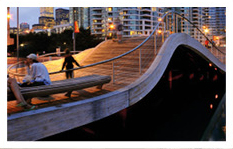
|
Our waterfront environments are astonishingly diverse, however, looking natonally, the renewal outcomes we often see are astonishingly homogenous. Rivers, bays, sea fronts, harbours, climatic orientation, tidal variance, demographics and a host of other factors give an almost endless palette from which to create great places. Despite this, the linear boardwalk is often the ubiquitous response.
More considered responses develop our waterfronts as a series of unique nodal spaces that are connected by a secondary unifying element. This approach delivers a public environment that is characterised by a series of more intimate and locally relevant spaces, each with a specific strategy for engaging with the water. In this way, the contemporary waterfront achieves both intimacy and the sense of wider coherence.
The South Perth Foreshore Master Plan articulates a clear vision for the 3.5km of Swan River waterfront.
The plan includes strategies for the delivery of a range of memorable spaces and experiences that are linked along a linear waterfront. The project will upgrade this impressive stretch of public open space into a destination that appeals to the full cross section of the population.
A terraced, urban harbour landscape, the Harbour Bath offers a variety of spaces for recreation and play. As an extension of the land, the “harbourscape” provides key focus for activity that caters for a wide variety of people.
|
A connection to the water itself is the greatest asset of any waterfront site. Be it the rolling waves at the beach, a gently flowing river or an expansive harbour, the attraction of people to the water and the water’s edge is universal.
To take true advantage of waterfront sites, we need to ensure water remains the centrepiece of the design and the focus of any programming and activity within the space. Yet in today’s risk adverse environment, the opportunity to implement designs that allow people to get up close, touch and interact with the water’s edge can sometimes present challenges that are difficult to overcome.
A clear trend is to look for opportunities to introduce, artificially, the element of water into the design, building in opportunities to touch and play with water and blurring the line between land and sea.
Urbis led the design of the new $42m foreshore parkland at the mouth of Gladstone’s Auckland Inlet.
The redevelopment of the parkland included a new $3 million water play facility, a platform extending out over the water, fishing amenities, a waterfront boardwalk and a wet dock housing the HMAS Gladstone.
The water play park at Gladstone East Shores is a spectacular example of integrating children’s play, sub-tropical landscape, exciting lighting concepts and waterside entertainment into a family friendly attraction for the people of Gladstone. This facility will reshape how the waterfront is used and transform it from a simple parkland into a jewel in the crown of the city.
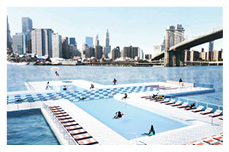 +Pool is a new project in New York, led by a team of young designers in what could potentially be the largest crowd-funded civic project of all time. It is an exciting example of one way a city can create new opportunities to interact with our waterways. Providing both an environmental and recreational benefit to the people of the city, +Pool is four pools in one combining a kid’s pool, sports pool, lap pool and lounge pool with a total capacity at any one time of 480 people. The cross-shaped swimming hole will filter the water while providing a dynamic new urban space in the East River.
+Pool is a new project in New York, led by a team of young designers in what could potentially be the largest crowd-funded civic project of all time. It is an exciting example of one way a city can create new opportunities to interact with our waterways. Providing both an environmental and recreational benefit to the people of the city, +Pool is four pools in one combining a kid’s pool, sports pool, lap pool and lounge pool with a total capacity at any one time of 480 people. The cross-shaped swimming hole will filter the water while providing a dynamic new urban space in the East River.
|
Our waterways have always been places full of activity, from the focus of industry to an essential transport mode and now as major recreational destinations and stages for civic events. The activation of these waterfront spaces is a key factor in their success.
Concentrating activity in and around carefully located nodes rather than thinly spreading it along a continuous edge ensures the creation of usable, safe and inviting spaces 18 hours a day. This also allows these nodes to be developed as identifiable destinations – be it cultural markers, commercial centres, or entertainment hubs, each with a distinctive identity, role and function. As destinations, they attract people and create the vitality that is essential for successful urban places.
As the premier arts and cultural destination in Queensland, the Cultural Precinct Master Plan integrates several well-loved public institutions into a chain of linked public destinations. A range of initiatives aims to elevate the precinct towards becoming a truly integrated tourism, entertainment, innovation and cultural destination.
Culture and place are the core principles of this public building. The intuitive and practical sculptural exterior form transforms the building into an extension of the city with a sloping public forecourt cascading down to the river and an accessible roof providing spectacular vistas.
|
Waterfronts are some of the earth’s most dynamic places. From daily tidal cycles to storm surges and the long term impacts of climate change, our waterfronts are always changing. While managing the daily flux has been part of our design considerations for some time now, it is the incremental change that is some of the most difficult to deal with. However, design is a powerful tool to imagining creative solutions and offer incremental investment strategies that future proof some of our most important amenity and community assets.
Urbis has just completed the master planning and is about to embark on the delivery for 2.5 hectares of prime waterfront space for the City of Rockhampton in Queensland. The design delivers an activated open space that links back to the CBD and responds to the flooding of the Fitzroy River.
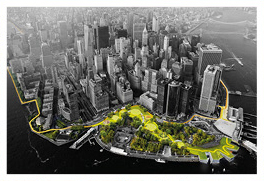
An ambitious protective system around Manhattan, this design competition winner seeks to shield Manhattan against floods and stormwater through an elevated public realm. Three compartments provide a flood-protection zone, whilst also providing community amenity along the river.
|
Most waterfront sites, by their very nature, are linear in form. This has the benefit of focusing activity at the water’s edge but the distinct disbenefit of encouraging longitudinal movement patterns at the expense of perpendicular connections between the waterfront and inland development.
A key outcome is often to boldly transect the waterfront with clear linkages that connect the water’s edge to other parts of the city that creates a ‘super grid’ of connectivity tying together communities, employment centres, cultural institutions and transport nodes to the amenity of the waterfront.
The renewal of Queen’s Wharf Brisbane represents a once-in-a-generation opportunity to integrate a truly mixed-use development and relink the city back to what is arguably the most important heritage site on the Brisbane River.
This project will transform a part of the riverfront that has been marginalised and disconnected from the city centre since the introduction of the Riverside Expressway in the 1970s. Urbis, as the lead master planners on the successful bid, ensured that the existing fabric of the city core was reinforced and augmented with clear and legible connections from the “ridge to river”.
Formerly an industrial maritime site, this linear space has been transformed into a vibrant public space. The site built upon original port elements creates an inviting public realm that encourages city life to engage with operational waterfront industries. The upgrades link seamlessly into the surrounding fabric of Auckland City Centre as if they have always been part of the wider public realm network.
|
The beauty, and often high level of activity of our waterfront spaces attract people for many reasons. Be it active recreation, family picnics or major civic events, our waterfront spaces need to be flexible places that can accommodate both the every day and the extraordinary.
To achieve this flexibility, and to ensure that no one group dominates the water edge, ‘designing in’ conflict, in the form of shared vehicular and pedestrian nodes, weaving cyclist and pedestrian routes and intersecting gathering spaces can provide the important opportunities to pause, gather and engage with the waterfront.
Urbis, in partnership with Crone Partners, won the competitive bid tender to design the Rhodes Community Centre in Sydney’s Canada Bay.
The design includes a large amphitheatre that intersects with a linear boardwalk. The overlap of these elements at the water’s edge deliberately ensures that people moving and people lingering intersect. This creates a diversity of user groups and enables opportunities for discovery and engagement.
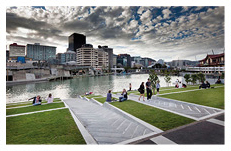 This project is the last piece of the jigsaw of Wellington’s waterfront public domain. The design elegantly resolves a range of complex uses and connections resulting in interesting geometries that offer clear movement through the space whilst still creating points of overlap and interest.
This project is the last piece of the jigsaw of Wellington’s waterfront public domain. The design elegantly resolves a range of complex uses and connections resulting in interesting geometries that offer clear movement through the space whilst still creating points of overlap and interest.
|
Many waterfront spaces, particularly those in the inner-city, are regionally significant places and the level of investment, amenity and facilities attract significant numbers of visitors at all times of the day.
Whilst the ultimate objective should always be to create sustainable places that rely on public and active transport infrastructure, the reality of most Australian cities is that the density of population and infrastructure networks is not sufficiently developed to support renewal without significant car parking, at least in the short term.
Ensuring these are carefully designed and located to be sleeved by activity or buried by landscape is essential. Ease of access is critical, but not at the expense of the quality of the experience once there.
In recognition of the outstanding potential to cement the iconic characteristics and grow the tourism and recreational value of the city, Suva City Council appointed Urbis and Woods Bagot, to prepare a master plan for the Suva Foreshore.
The process to develop a master plan for the foreshore was centred around the ability to improve both legibility and physical access to the waterfront itself. Hampered by built form that is perpendicular to the shoreline, the master plan creates a series of new connections and access routes to completely open up the waterfront and connect it seamlessly with the surrounding urban grid of Suva City Centre.
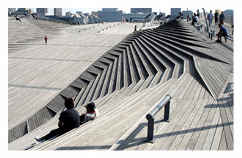 Foreign Office Architects
Foreign Office ArchitectsThis port terminal includes a significant transport interchange incorporating car parking, ticketing and connections to bus and rail. A series of folded surfaces sits on top of the terminal creating an architectural topography and dynamic public space.
|
The spaces and linkages associated with the water are obviously the key experience of waterfronts. However, they are often unable to reach their full potential as active places for people unless the density of residential development and intensity of commercial uses is sufficient to bring them to life. For many years the idea of ‘commercialising’ waterfronts has been politically unpopular, perceived by some as diminishing the public nature of these spaces.
Nothing could be further from the truth. Urban life, exchange, interaction, choice, and true public life are the result of development density. Of course change is important too. A continual process of place management, tenant improvement and renewal is required to keep the ‘mix’ relevant and the public realm activated to the point that success is inevitable. Waterfronts must work hard and, in most instances, perform commercially to underpin their success.
The Urbis master plan for the Iskandar waterfront in Johor Bahru strategically positions itself for outward growth from Singapore. The master plan leveraged the locational and lifestyle advantages of the region to promote growth, density and investment. Clear precincts and opportunities for highly programmed places are built on an outstanding waterfront.
This mixed use precinct is set to incorporate civic, residential, retail, commercial and cultural attractions set around a picturesque inlet that re-establishes Perth’s historic link with the Swan River. The development occupies 10 hectares of prime riverfront at the base of the CBD and delivers a high quality urban environment featuring promenades and boardwalks. Previously the Esplanade Reserve, Elizabeth Quay was resumed by the government for redevelopment in 2012. Works are due to be complete in 2018.
Bringing together project teams that utilise the skills of our researchers, planners, economists, designers and social planners to provide clients with comprehensive and implementable advice, we are an integrated multi-disciplinary consulting firm with a unique and comprehensive service offering.
With offices in Sydney, Melbourne, Brisbane and Perth we offer a national service that is supported by local market knowledge and experience. Our consultants share information and findings to ensure advice is based on best practise processes and unique market insights.
Committed to providing practical solutions and creating measurable value, we bring informed advice that preserves your vision and goals. With Urbis, you tap into a trusted resource that complements your own capabilities.